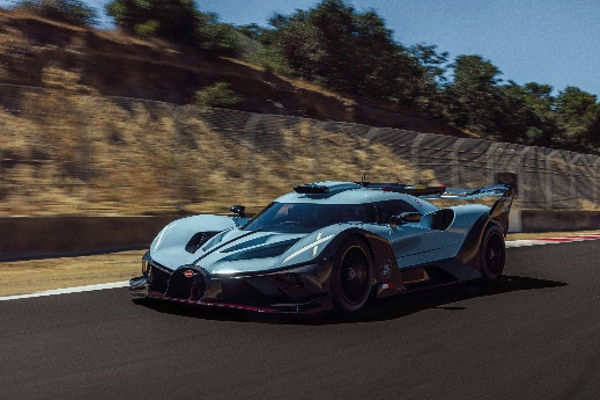For the Bugatti Bolide, a hypercar with electronic stability control (ESC), traction control system (TCS), and anti-lock braking system (ABS), Continental has created an electronic brake control system based on the “Motorsports ABS Kit by Continental Engineering Services.”
Both professional racers and enthusiasts may handle the 1,600 horsepower racing car thanks to its motorsports brake control system. The hypercar manufacturer’s incredibly potent racing vehicle, the Bugatti Bolide, is only authorized for use on racetracks.
The Bolide, which was first envisioned as a concept car based on the Bugatti Chiron production model, is currently being produced in a limited quantity of 40 pieces, with the first deliveries anticipated before the end of the year.
For a number of years, Bugatti and Continental Engineering Services (CES), the company’s in-house development and engineering service provider, have collaborated on cutting-edge advancements, especially for the Bugatti Chiron and Bugatti Veyron models.
The creation and integration of hardware and software components makes the current project unique because racing cars that aren’t authorized for use on public roads are typically designed for maximum performance and don’t typically have this kind of intricate driving dynamics system.
Christian Willmann, Bugatti’s chief engineer for the Bolide, explains: “Never before has an ESC system been combined with carbon-carbon brakes—until now. With the Bolide, we’ve achieved this breakthrough, creating a solution based on Continental’s motorsport brake control system that surpasses our expectations in performance, stability, and safety. Continental’s Motorsports ABS makes the Bolide even more exceptional.”
“We’re extremely proud that we were able to push boundaries with Bugatti in this extraordinary project,” adds Volker van Lier, head of the Chassis & Brake Systems business unit at CES. “Developing brake control technology for a hypercar is an exclusive discipline in which Continental Engineering Services has a great deal of experience. Making a racing car controllable not just for professional motorsport racers, but for all drivers, was a particularly interesting challenge for us.”
The challenge: to make a 1,600-horsepower hypercar controllable for anyone
For this sports car project, CES was able to draw on its extensive experience in the motorsports industry and on its work for Bugatti.
Brake control systems for the Veyron and Chiron production hypercars (the Bugatti Bolide is based on the Chiron chassis) have already been created by the development service provider. For all of its motorsport customers, CES also offers a basic Motorsports ABS, which has been modified and improved with new features especially for the Bugatti Bolide.
The CES Motorsports team took on the task of creating a car with exceptional driving dynamics that every driver could manage while creating the personalized product. Despite having 1,600 horsepower, the vehicle’s acceleration and braking forces required to be carefully controlled to guarantee safe steering and handling.
This is made possible by vehicle dynamics control systems. In every situation, the 1,600 horsepower output is controlled by the traction control system to provide the most propulsion possible.
While the electronic stability control keeps the car stable even during difficult maneuvers, the anti-lock braking system guarantees the best braking performance independent of the outside circumstances.
This kind of private car, which was purposefully not made for public roads, must satisfy the exacting standards of professional racers while yet being safe for novice drivers. A brake control system that enables the activation or deactivation of specific driving dynamics functions as required was the answer.
The participation of an engineer from Continental Engineering Services who is also a licensed racer was one of the benefits of this development. He assisted in optimizing the control systems for racetrack performance by working with the manufacturer’s factory drivers.
For the anti-lock braking system and the electronic stability and traction control combo, the Bugatti Bolide brake control system offers five distinct driving modes. Pure race mode, a gradual activation of the driving dynamics control, and significant use of technological assistance are some of these modes.
Depending on the track, weather, and tire condition, driving characteristics can be changed directly on the steering wheel. The adaptable CES system adapts to variations in braking balance between the front and back axles with ease.
Regardless of whether the tires are cold or properly warmed up after a few laps on the racetrack, this enables exceptional braking performance at all times.
Software expertise paired with motorsport know-how
One specific difficulty was dealing with the intense physical pressures typical with motor racing. When braking, the 1,600 kg sports car can decelerate up to 2.5 g, which is more than twice as much as what a road-legal vehicle can decelerate.
The CES motorsport braking control system’s control methods also had to account for the aerodynamic downforce at high speeds, since the 380 km/h car puts more than twice as much strain on the wheels at high speeds as it does at rest.
The in-house software package for the basic Motorsports ABS had to be modified and expanded to satisfy these strict standards; the control function algorithms were improved to subdue the Bolide’s exceptional dynamics.
Thanks to these optimizations, the systems were also able to fully develop their impressive performance as they interact with racing components such as the carbon-carbon brake system and special endurance slicks.
Although at first glance the brake control system seems inconspicuous, it is capable of maneuvering a 1,600 hp hypercar safely through tight hairpin bends and precisely controlling the brake pressure, even at top speeds of up to 380 km/h, all this while also weighing less than two kilograms and being no larger than a brick.
Speed was also of the essence during development: CES was able to develop the exclusive control system within just a year, from the initial meeting to the final driving test.




